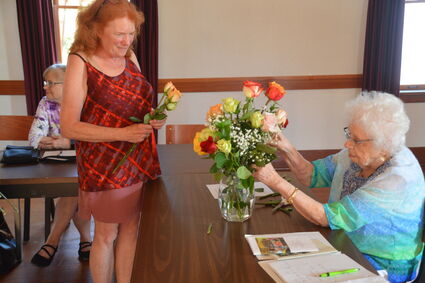Historic La Conner Civic Garden Club continues to cultivate good works
February 15, 2023
Before there was a Skagit Valley Tulip Festival, there was a La Conner Tulip Show.
And before the tulip show here, there was a La Conner Rose Show.
Plus a fall dahlia show.
All because, as the late Philena Dunlap noted 40 years ago this August, La Conner has long had the good fortune of having "a group of women who were dedicated in their desire to work together for the benefit of all in the town they loved."
That tradition took root with the founding in 1909 of the Civic Improvement Club of La Conner, Dunlap explained in a profile in a "Making La Conner Go" series run in the Channel Town Press newspaper in the early 1980s.
It is a tradition – a proud one, indeed – that endures to this very day through the good works of the entity formed when in 1954 the Civic Improvement Club merged with the La Conner Garden Club.
The now named La Conner Civic Garden Club still meets regularly in its landmark Second Street building, originally a Grange Hall and territorial courthouse and today a popular venue for meetings, weddings and all types of public gatherings.
"The organization continues to work on civic projects, providing food for the Pioneer Picnic, maintaining the Butterfly Garden at the Civic Garden Club Building, providing educational seminars and selling wreaths to town businesses," club president Kim Good Rubenstein told the Weekly News.
The club – whose roster includes endeared 104-year-old poet Joyce Johnson, an active member since the 1954 merger – remains a vital link between the town's past and present.
"I think I was struck by the generational history of our members," Rubenstein said upon reflection, "and the opportunity for new members of our community to join the club and become involved in our activities."
Its mission has always been both a product of and purposeful response to the times.
That goes back to the founding of the Civic Improvement Club, whose constitution and by-laws were signed by nearly 70 women.
"An immediate effort," Dunlap, a revered La Conner teacher who joined the CIC in 1924, said nearly 60 years later, "was made to form sub-groups to assume the responsibility of cleaning up different sections of town.
"Plans were made," Dunlap learned from tireless research of the club's minutes, "to hire boys to pack rubbish at a wage of three sacks for a nickel or 15 cents an hour. The decision was also made to have a delegation visit the Town Council to urge that livestock be kept off the town streets."
With the town clean-up well under way, the club decided to sponsor a spring rose show, said Dunlap.
"It became the first of many in the years that followed," she reported, "and the La Conner Rose Show became well known to many rose lovers in the area."
More such events blossomed thereafter.
"A dahlia show in the fall," said Dunlap, "began a tradition of fall flower shows which grew to include garden produce and children's sections."
The flower shows were dropped during World War I and according to CIC records the club nearly dissolved but managed to lend support to the Red Cross and invest in Liberty Bonds.
After the war ended, the club resumed its local projects, including procurement of benches and picnic tables at Pioneer Park. CIC members also endorsed sponsorship of a Parent-Teacher Association and installation of highway signs in the La Conner area. By 1925, the club had secured the iconic building on the bluff overlooking town as its meeting place.
"Work on the building became a long-time continuing responsibility," Dunlap wrote in a formal history of the La Conner Civic Garden Club, "with rummage sales and dinner parties given to finance the new foundation and the work on the floor. Construction of the kitchen and restrooms were big projects assumed after the purchase of the building."
The 1930s saw the CIC serve meals at two major annual events – the La Conner Alumni Banquet and Skagit County Pioneer Association Picnic.
In 1951, the late Roberta Nelson proposed merging the CIC with the La Conner Garden Club, which had been founded the previous year and met at the Planter Hotel. Nelson credited Planter owner Olga Fahlen, a member of the Garden Club, with having successfully lobbied for the consolidation.
"She suggested," Nelson said in a two-page written account, "that the two clubs merge to form one club that will work toward the civic good of the community."
Prior to the formal merger, the two clubs had reached agreement to jointly sponsor spring tulip shows in La Conner.
Those shows drew thousands to the old La Conner High School gymnasium, which had been constructed with volunteer labor in 1948 and garnered statewide publicity and recognition. Renowned artist Laurie Wells painted large murals, developed waterfalls and pools and brought in trees and wildflowers – transforming the gym into what Dunlap termed a "natural wonderland."
"The show," wrote Dunlap, "would not have been possible without the wonderful cooperation of the local tulip growers who picked their thousands of choice flowers and brought them in to the gymnasium. The show also required the hard labor of club members who prepared the display beds. This was an effort which required loads of sawdust and large quantities of sword ferns.
"Moss gatherers," she added, "went far and near to collect moss to cover the sawdust and give the beautiful woodsy look that added so much to the beauty of the shows."
The tulip shows in La Conner continued into the early 1970s, ending their run not long after Wells' retirement.
The Civic Garden Club shifted gears and through ensuing generations has remained an active and productive organization, perhaps most visible in its role serving the barbecue salmon luncheon at the Pioneer Picnic each August.
The club looks forward to making yet more history while cherishing its time-honored role in having helped define La Conner's heritage.
Rubenstein is hoping to further chronicle that legacy.
"I've loved reading about all the past club activity," said Rubenstein, who has served as president of the Skagit County Pioneer Association. "I'm thinking of compiling the information into a book about the history of the club."
For many locals, that project would qualify as must reading.









Reader Comments(0)